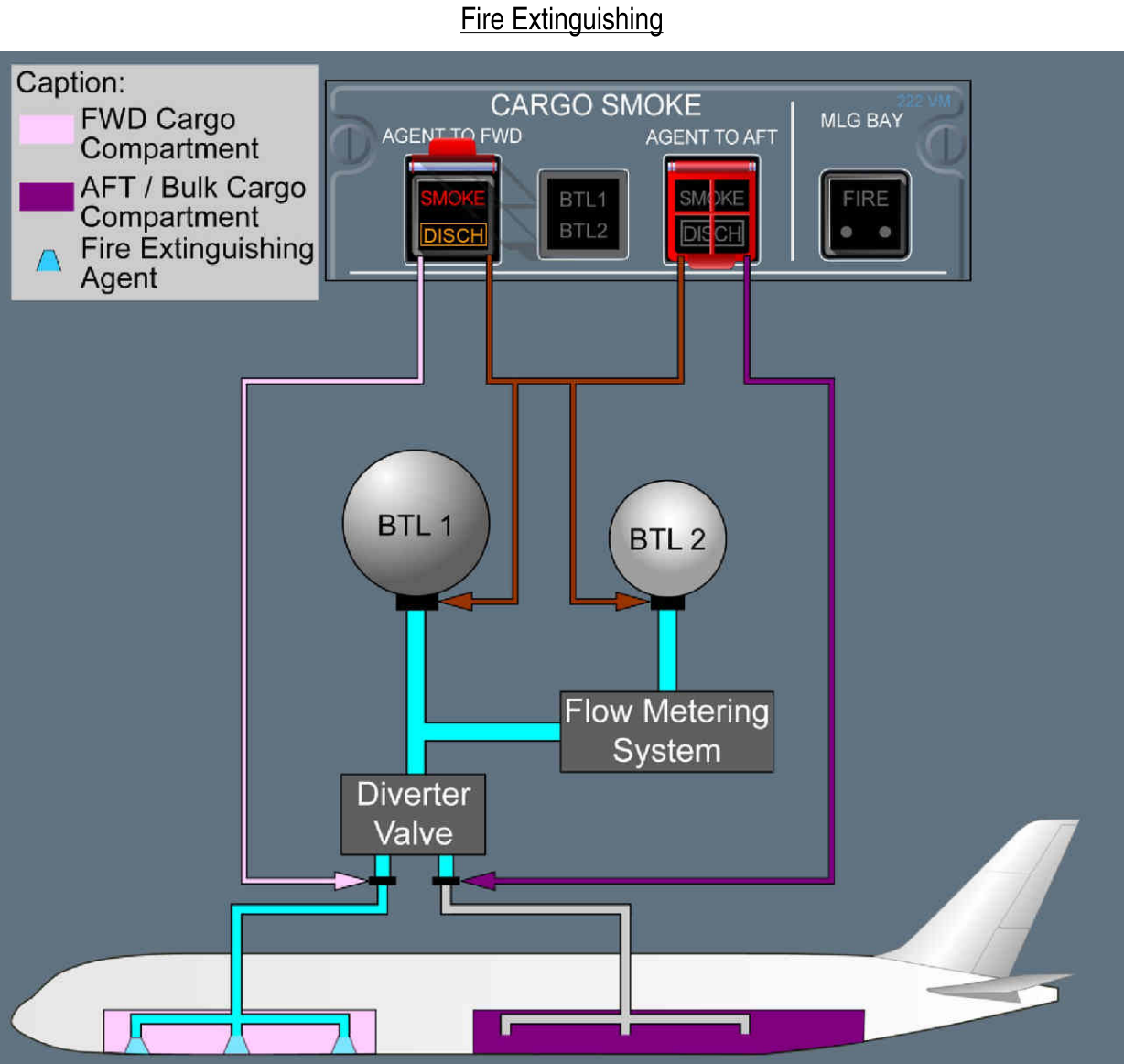A350 еүҚиҙ§иҲұе’ҢеҗҺ/ж•Јиҙ§иҲұе…ұз”ЁдёӨдёӘзҒӯзҒ«з“¶пјҢ1еҸ·зҒӯзҒ«з“¶еңЁ1еҲҶй’ҹеҶ…еҝ«йҖҹйҮҠж”ҫзҒӯзҒ«пјҢ2еҸ·зҒӯзҒ«з“¶еңЁеҗҺз»ӯй•ҝж—¶й—ҙеҶ…зј“ж…ўйҮҠж”ҫд»ҘдҝқжҢҒзҒӯзҒ«еүӮжө“еәҰгҖӮ
еҜ№жӯӨи®ҫи®ЎпјҢжңүеҮ зӮ№з–‘й—®пјҡ
- еҒҮи®ҫеүҚиҙ§иҲұеҮәзҺ°зғҹйӣҫиӯҰе‘ҠпјҢжңәз»„жҢүеҺӢ AGENT TO FWDпјҢйҮҠж”ҫдәҶ1еҸ·зҒӯзҒ«з“¶пјҢд№ӢеҗҺеҗҺиҙ§иҲұеҸҲеҮәзҺ°зғҹйӣҫиӯҰе‘ҠпјҢеҶҚеҺ»жҢүеҺӢ AGENT TO AFTпјҢ2еҸ·зҒӯзҒ«з“¶дјҡйҮҠж”ҫеҲ°еҗҺиҙ§иҲұд№Ҳпјҹ
- еҰӮжһңиғҪйҮҠж”ҫеҲ°дёӨдёӘиҙ§иҲұпјҢжҳҜеҗҰж„Ҹе‘ізқҖжҠ‘еҲ¶ж—¶й—ҙдјҡдјҡзј©зҹӯпјҹ
- еҰӮжһңдёӨдёӘиҙ§иҲұзҡ„иҙ§зү©зұ»еһӢзӣёеҗҢпјҢйҒӯйҒҮеҗҢж ·зҡ„зҺҜеўғпјҢжҳҜеҗҰеҸҜиғҪеҗҢж—¶иө·зҒ«пјҹжңүжІЎжңүеҝ…иҰҒи®ҫи®ЎдёӨдёӘеҝ«йҖҹйҮҠж”ҫзҡ„зҒӯзҒ«з“¶пјҹ
з©әе®ўи§Јзӯ”еҰӮдёӢпјҡ
- дёҚз®ЎжҳҜ1еҸ·иҝҳжҳҜ2еҸ·зҒӯзҒ«з“¶пјҢеңЁйҮҠж”ҫжңҹй—ҙпјҢеҰӮжһңжҢүеҺӢеҸҰдёҖдёӘйҮҠж”ҫжҢүй’®пјҢе°ұдјҡеҗҢж—¶йҮҠж”ҫеҲ°дёӨдёӘиҙ§иҲұгҖӮ
- жҳҜзҡ„пјҢдјҡеҮҸеҚҠгҖӮ
- иҝҷз§Қжғ…еҶөеӨӘжһҒз«ҜпјҢз©әе®ўд№ҹжІЎжңүйҒҮеҲ°иҝҷз§ҚжЎҲдҫӢпјҢжүҖд»ҘеҸӘи®ҫи®ЎдәҶдёҖдёӘж»Ўи¶ідёҖдёӘиҙ§иҲұзқҖзҒ«зҡ„зҒӯзҒ«еүӮйҮҸгҖӮ
еҸҰеӨ–з©әе®ўе»әи®®еҰӮжһңдёӨдёӘиҙ§иҲұеҗҢж—¶зқҖзҒ«пјҢдёәдәҶзЎ®дҝқеүӮйҮҸи¶іеӨҹпјҢе»әи®®еҸӘзҒӯдёҖдёӘиҙ§иҲұзҡ„зҒ«вҖҰвҖҰиҝҷдёҖзӮ№жҲ‘и§үеҫ—еҖјеҫ—еҶҚе•ҶжҰ·гҖӮ
е…·дҪ“иҜ·еҸӮиҖғ Tech Request еҺҹж–Үпјҡ
Q:
As we known of cargo compartment fire distinguishing system of A330 and A350, bottle 1 discharges within 1 min, and bottle 2 discharges within a long time.
If fwd cargo compartment gets fire first, and later the aft cargo compartment. Bottle 1 can only discharge once, how can we deal with the second fire case. If we push the AGENT TO AFT (AFT AGENT for A330), what will happen? Will the bottle 2 discharge to both cargo compartment? And if it is, the duration of bottle will reduce and cannot cover the enough time. If it isn't, we just let the 2nd fire going on?
If there're same cargo in both compartment, which is just like medical equipment we carrying nowadays, and encounter the same situation causing fire, will them get fire one by one or even simultaneously? I don't know the probability of this extreme case. But I think there should be some way to handle it. For example, why not designing 2 fast-discharging bottle for both compartment respectively?
A:
Airbus reviewed your query, and we would like to provide CSC with the following information:
We confirm that it is possible to discharge the Agent 1 to both cargo compartments. However, the probability of the fire situation in both compartments is extremely low and Airbus has never received any report about this scenario. Therefore, the system for both Agents is designed to extinguish fire in only one compartment, either in FWD or AFT cargo compartment. If both agents are activated in the FWD and AFT cargo compartments, the bottles will be emptied within half of the designed fire suppression time.
In the case of fire in both compartments at the same time, the flight crew should consider extinguishing fire in only one compartment (either in FWD or AFT cargo compartment) in order to ensure sufficiency of the agents.
As Agent 1 is discharged with a high flow rate to the affected compartment, and Agent 2 is discharged with regulated Halon flow. The Agent 1 is discharged in order to initially suppress the fire while the Agent 2 is discharged after the Agent 1 in order to compensate the cargo compartment leakage. The purpose of this design is to maintain the extinguishing Agent concentration over a period of time until aircraft landing.
Therefore, in the case that fire occurs in another cargo compartment with the Agent 1 already discharged, the Agent 2 can be discharged. However, the amount of the Agent 2 is not sufficient to suppress fire in another compartment.
As mentioned, the probability of the fire situation in both compartments is extremely low and Airbus has never received any report. Therefore, only one compartment is considered to ensure sufficiency of agents in case of fire.
We hope this satisfactorily responds to your request, and we remain available for any additional information and assistance.

